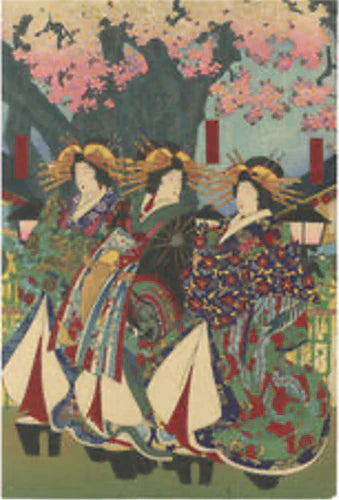
Boulevard of Flowers

Bustle in the Boulevard of Flowers by Chikanobu Toyohara (1890)
It is time of celebration of cherry blossoms in the Edo pleasure quarter and the most beautiful courtesans are portrayed clad in their most fabulous kimonos admiring the flowers. They are compared to being exquisite flowers, to be admired, which is another reason for the use of the word "flowers" in the title.
While the artist depicted faces and hairdos of courtesans with relatively little variations, he took special care in displaying a rich variety of designs of the ladies’ kimonos. Among an array of plants and flowers, such motifs can be noticed as an anchor, a dragon with a flaming pearl, a carp swimming upstream a waterfall, and a shihi - a mythical beast resembling a lion. Such elaborated designs could be embroidered, dyed, or painted onto the fabrics.
Asian art is filled with symbolism – one such example is the iconic motif of the carp fish swimming upstream, which is regarded to this day as a symbol of surmounting challenges and succeeding. This motif can be seen on the ornate obi belt adorning the courtesan portrayed in the centre of the triptych.
Interesting detail in this artwork is the portrayal of ladies wearing traditional Japanese garments, in contrast to some of the men depicted who are shown with Western hairstyles and fashions (such as the bowler hat). This highlights the gender divide that emerged in that period of Japanese history, when men were expected to embrace and take on the new era of Western fashion, while women were still bound to maintain the tradition.
Yoshiwara, as the Edo / Tokyo pleasure quarter was widely known, was an enclave of the “floating world”, separated from the rest of the city by moats and walls. Its central boulevard, depicted in this print, was akin a stage where top class courtesans called oiran would parade every afternoon wearing their lavish kimonos, surrounded by their attendants. In this work, the parade of top courtesans unfolds under the blossoming cherry trees, conveying the special festive atmosphere of the season and its celebrations around the cherry flower viewing or hanami, an ancient Japanese tradition observed to this day.
While physically separated from the city and the realm, thanks to Ukiyo-e prints the top courtesans were made famous all around Edo and beyond. Fashions emerging in the Yoshiwara were made popular beyond the pleasure district by the same token.
